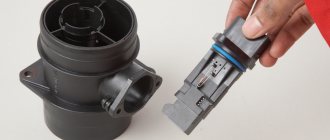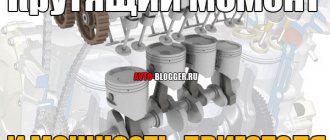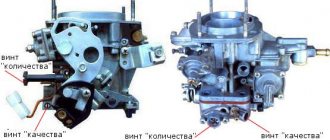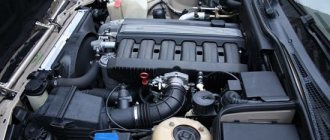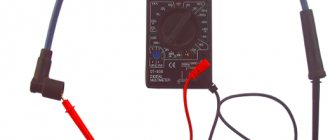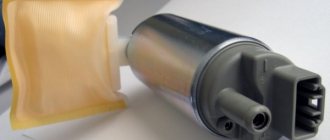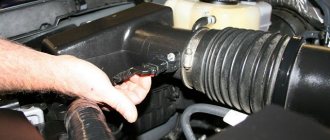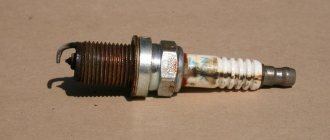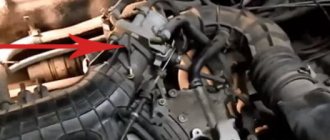Problems in the engine fuel-air system may be indicated by the following symptoms, which clearly manifest themselves during the operation of the car: idle speed fluctuates, the car stalls when braking, the engine stalls immediately after starting in a cold state.
Author: Raul_ HF and wheel alignment mechanic; experience - 3 years. Service/repair consultant at Toyota DC; experience - 4 years.
In some cases, a malfunction may be associated with malfunctions of components of other systems operating in conjunction with the fuel mixture supply system.
Possible causes of malfunctions:
- leakage of the brake booster vacuum hose
- faulty vacuum brake booster
- fuel filter dirty
- fuel pump is faulty
- The idle air valve is faulty or heavily contaminated
- malfunction of ignition system components
To identify the exact cause, it is necessary to check the condition and performance of all the above components and assemblies.
Vacuum hose leakage
A leak in the hose connecting the vacuum brake booster to the intake manifold allows excess air to enter the system. This may be a very small crack or break that is difficult to notice with the naked eye. When the car moves under the influence of air flow, it expands and causes an undesirable effect. Such symptoms may not appear locally. The entry of air into a discharged intake manifold depletes the combustible mixture, which leads to a partial or complete loss of engine speed.
The solution is to repair or replace the hose.
Finding the fault yourself
If the engine speed fluctuates, you can try to find the cause of the unstable operation of the engine on your own. What to check first:
- Remove the air filter and inspect it for contamination;
- Unscrew the spark plugs, check the condition of the electrodes and the correctness of the gap setting;
- With the engine running (idling), unplug the connector from the mass air flow sensor. If the nature of the operation does not change, it is likely that this sensor is faulty;
- Inspect the throttle valve corrugation. If it is torn, or the clamps securing it are not tightened properly, this could easily be the reason for the “floating” speed.
Brake booster malfunction
The vacuum brake booster can only operate when the engine is running. The vacuum chamber of the brake booster communicates with the intake manifold, where a vacuum is created, through a check valve and a connecting hose or tube. When the engine stops, the check valve closes, disconnecting the vacuum chamber of the amplifier and the intake manifold.
When the engine is off, the brakes operate only from mechanical force directly on the pedal. The amount of vacuum remaining in the chamber may only be enough for two or three brake presses without applying excessive force to stop the car.
A malfunction of the check valve or the vacuum seal itself also leads to air entering the system during braking. As a result, the mixture becomes leaner and the car stalls. The malfunction can occur both on cars where the carburetor is responsible for supplying fuel, and on the injector.
It is easy to check the performance of the vacuum booster. Just hold down the brake pedal and start the engine. A working vacuum booster will make the pedal softer and when you start the engine it will feel like it will fall. Otherwise, replace the check valve or amplifier.
How to identify floating speeds
A car engine is one of the most complex and expensive components. It is not that difficult to keep track of all changes in its operation, and the benefits of a few minutes of attention to the machine are quite concrete. A car enthusiast can determine the presence of floating speed by the following symptoms:
- Sounds.
- Vibrations.
- Tachometer readings.
The tachometer allows you to notice changes in engine operation. Engine idling should be displayed on the device at a stable 7-8 hundred revolutions. If there are significant fluctuations in the needle up or down, then we are talking about floating speed. The sounds and vibrations of the car will help to distinguish them from a tachometer malfunction.
The sound of a working motor is stable; there are no changes in timbre or volume. When the noise of the engine compartment first increases to a hum, and then decreases to barely audible, then there is every reason to talk about floating speed. An additional argument in favor of this version will be the difference in vibrations emanating from the machine that corresponds to the noise.
Detection of problems is a reason to contact a car service center for diagnostics of the internal combustion engine. Carrying out diagnostic measures is necessary to identify the cause of problems. The main feature of the problem we are considering is the multiplicity of its potential causes. It will be useful to consider them in detail.
Contamination or failure of the idle air valve
The idle valve is designed to maintain high speeds on a cold engine when warming up and ensure minimum speeds when the engine is idling. It also prevents the speed from falling below the set limit when the throttle is closed. Contamination of the valve makes it impossible to operate normally and can cause insufficient air supply to the injection system, which causes interruptions in the operation of the engine, even stopping. Symptoms usually appear when the accelerator pedal is suddenly released. This usually does not happen on gas.
Where to begin?
Strictly speaking, the possibility of encountering the problem of jumping speed increases among owners of injection engines. This is due to a rather complex electronic control system (ECM) that regulates the operation of this type of engine.
Control is carried out using numerous sensors that transmit the collected information to the vehicle’s organs. As they say, the more complex the system, the more possible problems can be detected in it. In general, instability of revolutions (slight) sometimes occurs on a cold engine, but when the revolutions fluctuate on an already warmed-up engine, this is, as they say, bad manners.
Despite the abundance of possible culprits, we can identify the main ones that cause the speed to fluctuate on a cold engine:
- Often the culprit of the problem is the idle air regulator, which receives information from the aforementioned ECM. Having received incorrect information, the IAC is not able to correctly adjust the engine speed at idle and select the type of fuel mixture required for this mode. To put it simply, the engine does not understand that it is now idling and begins to make tricks that are uncharacteristic for such a move. So the IAC is the first thing that will be checked during diagnostics at a car service center.
- Another sensor that is one of the most naughty is the air flow sensor. The effect is similar to a malfunction of the IAC - the engine control unit (ECU) receives unreliable information about air flow, which will negatively affect the composition of the air-fuel mixture.
- Problems with the throttle or its damper. Contamination and mechanical failures usually occur. For example, incomplete opening of the damper, or damage to the throttle.
Malfunction of ignition system components
A malfunction of the ignition system makes it impossible to ignite the combustible mixture at the appropriate engine stroke. This manifests itself as regular misfires, disrupting the stability of its rotation. The revolutions float, when you press the accelerator they do not increase or increase with difficulty, the engine troits and may stall. All this is accompanied by thick exhaust smoke, which is uncharacteristic of normal fuel combustion.
The malfunction may be due to wear of spark plugs, armor wires, or ignition coils. Also, the reason may lie in incorrect setting of the ignition timing on engines with a distributor. All components of the system are subject to inspection and troubleshooting; after identifying a defective part, it must be replaced or adjusted.
Instability of internal combustion engine operation under various conditions can be caused by a number of reasons. This is why comprehensive diagnostics of equipment and components associated with the fuel-air system is required if the idle speed fluctuates.
Almost all modern cars are equipped with electric fuel pumps. The breakdown of these relatively simple and inexpensive devices leads to serious troubles along the way: the engine stops working and starting steadily, stalls while driving, or even completely refuses to function for no apparent reason. It would seem that there is fuel, there is a spark, but the car refuses to move. To avoid getting into trouble on the road, we recommend that you read our recommendations for identifying this common malfunction. Advanced motorists will be able not only to quickly detect a breakdown, but also, possibly, to deal with it independently in the field.
What is a fuel pump
It is not difficult to guess that a gas pump is needed to supply the fuel in the car tank to the internal combustion engine. But this is far from his only task. In modern injection systems, it also maintains a certain pressure in the fuel rail, without which normal engine operation is impossible. On some vehicles, not one, but two pumps are installed - one in the gas tank, and the second on the fuel rail: the first pumps fuel from the tank to the supply line, and the second maintains a constant pressure inside it, necessary for the operation of the fuel injectors. The gas pump must pump a certain volume of fuel and at the same time maintain a sufficiently high pressure in the power system.
Symptoms that the speed is floating
You can recognize unstable, jumping operation, namely floating engine speeds, without any problems.
This is most acute at idle speed, which, if there is a problem, causes the tachometer needle to perform miracles of acrobatics. When the tachometer needle jumps from 300 rpm to 1300, then drops to 500 and back - this is not normal. And all this without your participation.
If suddenly your car model does not have a tachometer or an on-board computer, the problem will be indicated to you by the sound of the engine running, which at idle will either become louder (transmitting a noticeable vibration into the cabin), then subside, as if returning to normal. In addition, you will feel a dip in movement when you start to pick up speed. Especially in high gears. Another problem may appear when you turn on the heater or cooling in the cabin - the engine will respond to this with a loud, dissatisfied hum.
If this is your case, then there is no doubt - a crisis period has come for your engine, and it needs repair. But what exactly needs to be repaired or changed? Here you cannot do without serious diagnostics.
Why does the engine speed fluctuate?
If the speed fluctuates on warm engines, then the cause of this may be an unadjusted carburetor. There are two bolts on the device for adjusting the fuel supply. There is a possibility that adjusting them will be useful. If, based on the results of the adjustment, the vehicle continues to show symptoms of problems, then the problem is deeper and a detailed inspection is necessary.
You may notice floating speeds when warming up due to contamination of the carburetor. When contamination of the system has been established as a fact, then it is necessary to remove the device and rinse it with a special compound.
Once the part is reinstalled, the fault should be corrected.
The idle air regulator, if installed on a vehicle, may cause floating engine speeds. To determine its role in the occurrence of problems, you will need to dismantle the part and conduct a visual inspection. If signs of wear on the regulator are detected, it should be replaced.
Changes in the operating power of a car engine can also occur due to a completely trivial reason: worn spark plugs. On average, spark plugs are designed for a mileage of 40-50 thousand km. If they were not replaced at the specified interval, then you can try to fix the problem yourself. To do this, it will be enough to simply replace the spark plugs.
